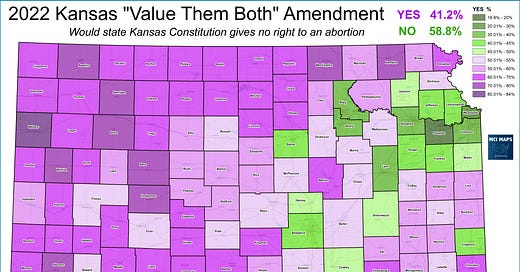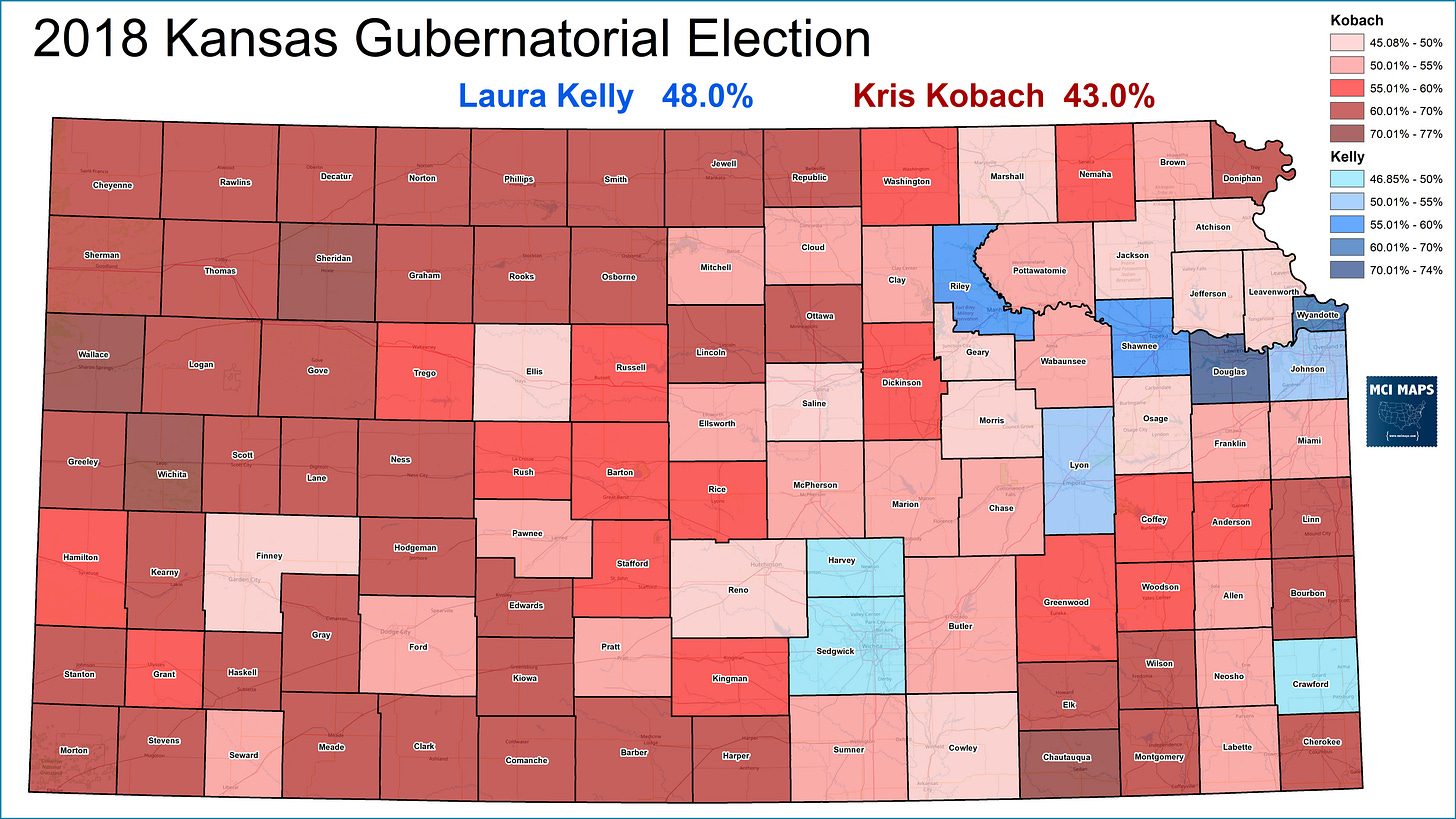Issue #62: A Detailed Look at the Kansas Abortion Referendum
How the Pro-Choice side got a 17 point win
On Tuesday, voters in Kansas went to the polls to cast ballot in Democratic and Republican primaries for a litany of offices. However, those primaries took a back seat to the state’s nationally-watched referendum on abortion. The GOP-lead legislature placed a constitutional amendment on the ballot; which if passed would have stripped the right to an abortion from the Kansas constitution. While abortion is not mentioned in the state constitution directly, the Kansas Supreme Court ruled back in 2019 that the state’s bill of rights covered the procedure. This amendment aimed to get around the court’s ruling. The measure is similar to a 2012 Florida measure, which I covered in this article.
The abortion referendum, called “Value them Both”, became a national focus in the wake of the Dobbs decision striking down Roe v Wade. Kansas was the first state to vote on abortion since the ruling - with several states planning referendums for November. The results were watched by political leaders, activists, and the press nationwide. A YES vote meant abortion was not protected in the constitution, a NO vote meant the status quo (aka abortion as a right).
When the results were all counted, the amendment failed by 17 points. A massive victory for the pro-choice movement.
The amendment’s failure was certainly possible; as the lone poll on the subject showed YES leading by only be a couple points. This margin, however, is truly stunning. The results showed the measure only passing in the farm country; tanking in suburbs and urban centers on the east end of the state. The farm county margins were also not especially strong. Suburban communities, both Democratic and Republican, rejected the measure.
A Deeper Look
So how did the pro-choice side win in a state that is still generally conservative? To compare the measure to partisan races in Kansas, I wanted to look at the 2018 Gubernatorial Election. While President could be used, Biden only won 5 counties there, losing the state by 17 points. I wanted to use a closer race as a benchmark. In 2018, State Senator Laura Kelly defeated Secretary of State Kris Kobach by 5 points for the office of Governor. Kelly’s win was guided by the blue wave and Kobach’s endless stream of controversies. While Kelly won more counties than Biden, she did not win more than the NO campaign.
The YES % has very strong correlation with the Kobach % from 2018. This was, of course, not enough, as Kobach was far from 50%.
I decided to compare Kelly’s margin to the NO margin from the referendum. As the map below shows, a vast majority of counties saw NO far outpace Kelly. The outperformance was incredibly strong in the Kansas City suburbs. Most of the farm counties saw NO overperform, with a few key exceptions.
Two counties that saw NO underperform, Nemaha and Ellis, can likely be tied to their Catholic population. The Archdiocese of Kansas City and Wichita gave around $4 million to the referendum, pushing a YES vote. Both counties are over 20% Catholic, with Ellis home to a historic German Catholic population. Ellis stands out as the lone county with over 30% of its residents holding a Bachelor’s degree to see NO underperform Kelly.
Now, several other counties with Catholic shares just under, or at 20%, did see NO overperform, so this is not a perfect causation. Leavenworth, for example, is 21% Catholic, is well educated, but saw NO overperform by 18 points. That county is much more of a Kansas City suburb than Ellis (which sits in the middle of the state). All and all, many factors could play into individual counties decision on the amendment. Religion, education, and community also factor into this vote.
Turnout
The timing of the referendum for the primaries was clearly designed by Republicans to aid their chances of a YES vote. Kansas has far more contested GOP primaries than Democratic, and historically GOP primary vote totals far outpace DEM totals. However, the referendum saw a massive surge in voters; with far more ballots cast for the referendum than any partisan primary. In total, 900,000 ballots were cast for the referendum - blowing past turnout records in past primaries.
Looking at the partisan primary races with the most votes cast, and seeing how many votes were cast in the referendum, it appears around 170,000 people showed up to vote for the referendum; not a primary. The partisan breakdown of races is below. Far more GOP primary votes were cast, but it was nearly equaled by DEM and non-partisan voters.
The referendum was clearly the main attraction in the primaries. Around 18% of ballots were just for the referendum (based on the gap between referendum totals and partisan race totals). These votes were much more concentrated in eastern Kansas.
Not only did the surge of non-Republicans hurt the YES effort, but its clear many Republicans did not vote YES on the amendment. The YES side got 374K votes, which is far lower than the 464K that cast ballots for the GOP primaries. In many counties, YES votes didn’t even amount to 70% of the total GOP primary vote. Only in a couple counties did YES outpace the GOP totals.
Wyandotte county has the largest YES vote compared with GOP vote (7300 GOP primary votes vs 7900 YES votes). I don’t have precinct data yet, so I cannot be sure what the story is here. One speculation I had was that Wyandotte is the least white county in Kansas, and as my Florida article showed, the pro-choice side can underperform Democratic margins with non-white voters. However, the the 2nd least white county, Geary, showed YES far under GOP vote totals. Again, without precinct data for further analysis, I don’t want to blanket assume anything yet.
I imagine much more will be revealed in coming days and weeks. Final turnout figures and precinct data will tell more stories. In the meantime, its a huge pro-choice win.
What does this mean?
There is a large number of takes coming out of this referendum. Some are well grounded, others are too premature. One thing is clear to me, the GOP is overplaying its hand with abortion. In a state like Kansas, where I’d bet a majority of voters would back some restrictions, the fact this measure failed by 18 points is quiet the statement. The measure clearly caused a surge in pro-choice voters. In addition, I venture the horror stories coming out of other states gave many pro-life voters pause. Stories of 10 year old rape victims needing to travel for abortion, or worries about pregnancy complications not being treated property, can easily scare off voters who largely view themselves as “pro-life” but are not absolutists. The question was, did you trust the Kansas legislature to not push a full-on ban that gave little to no exceptions? The answer was clearly no.
Now, what does this mean for partisanship? This is still very hard to gauge. This referendum showed how votes might go on a ballot measure. However, will voters punish GOP politicians if they think they are going too far with restrictions? Does this mean any absolutist pro-life Republicans cannot win if the area favors some degree of freedom? There are example of politicians going to far on the issue; see my example below.


Well, that question makes me think of Florida again. In Florida, and countless other states, we have seen voters back or reject a ballot measure, and then contradict their vote with the ballot for partisan offices. For example, Florida voters approved a minimum wage increase the same day the voted for Trump and a GOP legislature. Republican politicians largely did not support the minimum wage proposal.
This type of contradictory voting happens all the time. Why? Because voters prioritize different issues with different races; or just blindly vote for their party loyalty. The big, and at the moment unanswered, question is how voters will rank the issue of abortion in November? Will pro-choice voters rank this as a top issue. Will this peel off pro-choice Republicans to cast ballots for Democrats?
I don’t have an answer for that. I venture it will vary from state to state. Stories coming out of states with full bans could likely keep shaping the public perception of this issue. How Republican politicians react to this result could also shape voting patterns.
We will have to wait and see. But as of right now, the first big political fight over abortion in a post-Roe world has been won by the pro-choice side.












